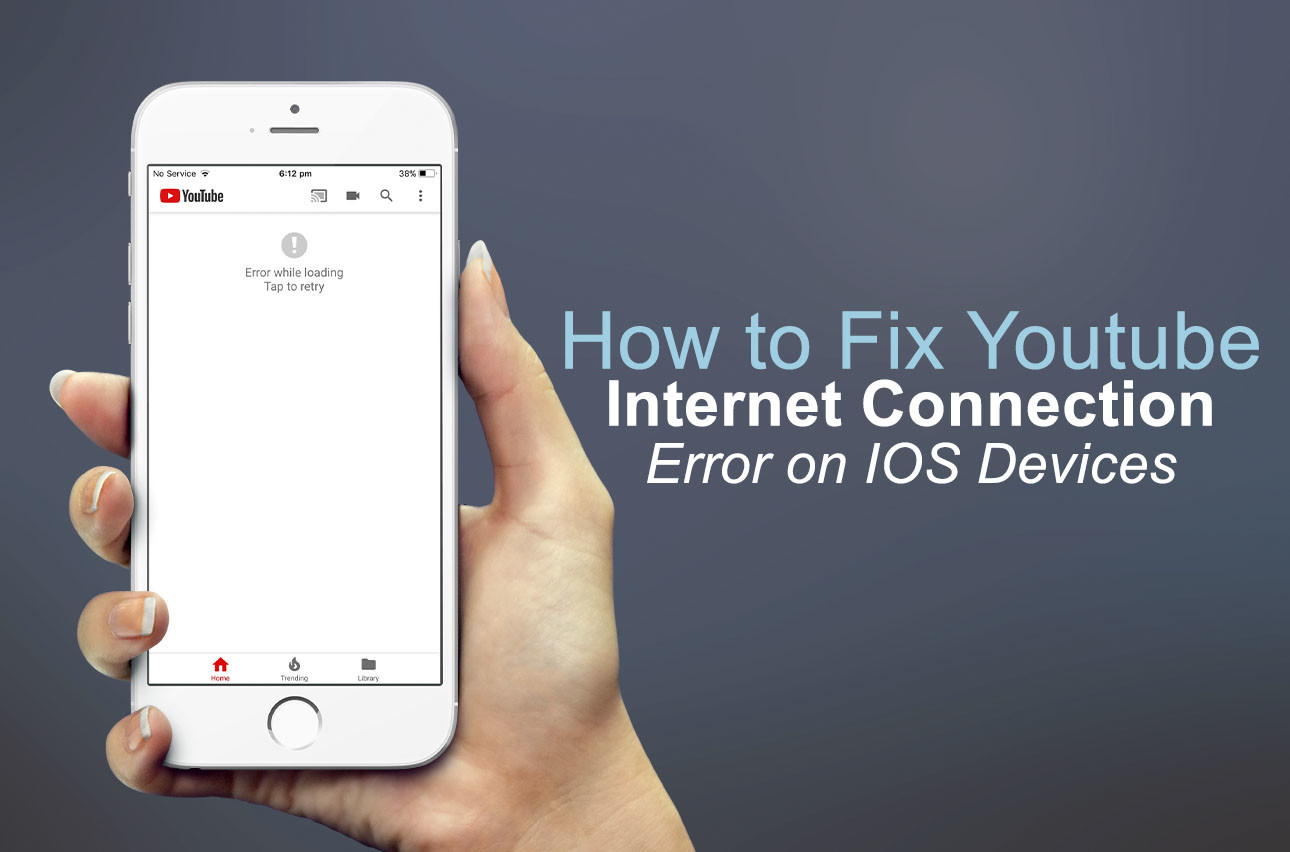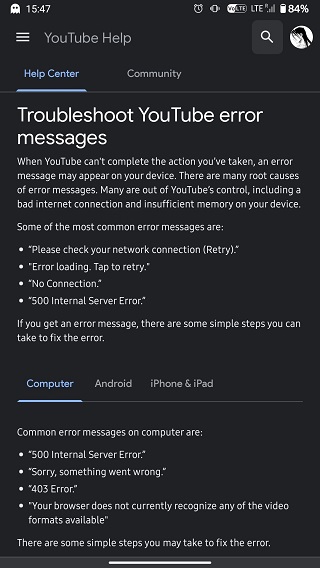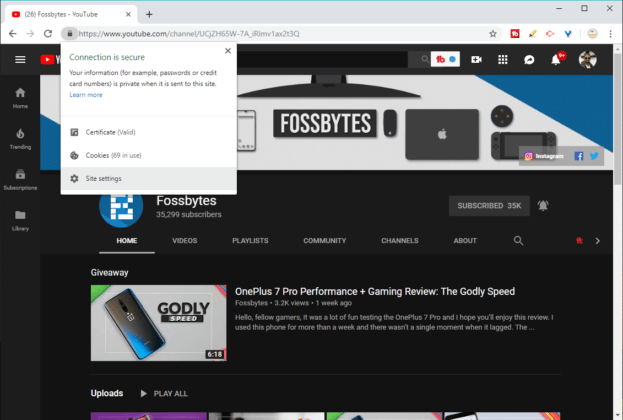Have you ever found yourself trying to watch your favorite YouTube videos on your mobile device, only to face frustrating access issues? You're not alone! Many users encounter this problem, whether it's due to a poor internet connection, app glitches, or other technical difficulties. In this blog post, we'll explore some common reasons for YouTube access issues on mobile, helping you troubleshoot and get back to enjoying your videos seamlessly!
Common Reasons for YouTube Access Issues on Mobile

When accessing YouTube on your mobile device, there are several potential culprits for access problems. Let’s unpack these reasons so you can identify where the hiccup might lie:
- Weak or Fluctuating Internet Connection: One of the most frequent issues is poor internet connectivity. If you're on a cellular network, signal strength can vary, and if you're connected to Wi-Fi, interference or network congestion could be the problem.
- Check your signal strength.
- Switch between Wi-Fi and mobile data to see if it makes a difference.
- YouTube App Glitches: Sometimes, the YouTube app can misbehave due to glitches. The app might freeze, crash, or fail to load videos altogether.
- Try closing the app completely and reopening it.
- Consider uninstalling and reinstalling the app for a fresh start.
- Device Compatibility: Older mobile devices may sometimes struggle to run the latest version of the YouTube app. If your device is outdated, it could lead to access issues.
- Check if your device meets the app’s requirements.
- Make sure your operating system is up to date.
- Insufficient Storage Space: Low storage can hinder app performance and prevent videos from loading. Make sure your device has enough free space.
- Delete unnecessary apps, photos, or files to free up space.
- Check the storage settings in your device’s settings menu.
- Server Issues: Occasionally, YouTube itself may experience server issues or outages. While these are less common, they can happen.
- Check social media or websites like DownDetector to see if others are experiencing issues.
- Wait a bit and try accessing YouTube again later.
Identifying the reason behind your YouTube access issues can make troubleshooting much easier. Whether it’s a quick refresh, a reset of your device, or checking your internet connection, most problems have a simple solution. Let’s keep your streaming experience smooth and enjoyable!
Also Read This: Can Youtubers See Who Viewed Their Videos? Privacy and Analytics Explained
3. Checking Your Internet Connection

When you find yourself facing access issues on YouTube, the first thing to do is check your internet connection. A stable connection is crucial for streaming high-quality videos without interruptions. Here's how to troubleshoot your internet connection:
- Check Wi-Fi Signal Strength: If you’re on a Wi-Fi network, take a moment to look at your device's Wi-Fi icon. If you see only one bar, you might be too far from the router. Move closer, if possible.
- Switch to Mobile Data: If you're on Wi-Fi but it seems unstable, try switching to your mobile data. Sometimes, cellular connections can be faster if your Wi-Fi is lagging.
- Restart Your Router: If you're at home, try restarting your router. Just unplug it, wait about 30 seconds, and plug it back in. This simple step can often resolve connectivity issues.
- Run a Speed Test: Use a speed test website or app to check your internet speed. Ideally, you should have at least 5 Mbps for smooth YouTube streaming.
Once you've ensured that your internet connection is stable, try accessing YouTube again. If you still face issues, don’t worry! Sometimes connection problems need a bit more digging.
Also Read This: Where is Fred from YouTube Now? A Look at His Life After Fame
4. Clearing Browser Cache and Cookies

If your internet connection is good and you’re still facing issues accessing YouTube, it might be time to clear your browser’s cache and cookies. These can sometimes cause problems by storing outdated or corrupted data. Here’s how you can do it:
- For Chrome:
1. Open the browse settings by tapping the three dots on the top right.
2. Select “More tools” > “Clear browsing data.”
3. Choose a time range (like “Last hour” or “All time”).
4. Make sure to check “Cookies and other site data” and “Cached images and files.”
5. Click “Clear data.”
- For Safari:
1. Go to “Settings” on your device.
2. Scroll down and tap “Safari.”
3. Select “Clear History and Website Data.”
4. Confirm by tapping “Clear History and Data.”
- For Firefox:
1. Tap the menu button (three lines) in the bottom right.
2. Go to “Settings.”
3. Tap “Data Management.”
4. Toggle the options for “Cached Web Data” and “Cookies,” then select “Clear Data.”
After clearing your cache and cookies, restart your browser and try accessing YouTube again. You might be surprised to find that this quick cleanup has solved the problem!
Remember, keeping your browser free of clutter not only helps with YouTube but enhances overall performance. So, make it a habit to clear out that old data occasionally.
Also Read This: How to Embed YouTube Shorts into Websites or Social Media Posts
5. Updating Your Mobile Browser
So, you’ve been navigating the vast world of YouTube on your mobile browser, and suddenly things aren’t working like they used to. One of the first things to check in these situations is whether your mobile browser is up-to-date. Just like any app or software, web browsers receive updates that not only introduce new features but also fix bugs, enhance security, and improve overall performance.
Here’s why updating your mobile browser is crucial:
- Improved Compatibility: YouTube frequently updates its platform, and an outdated browser may struggle to deliver the content properly. Newer versions are optimized to handle these updates seamlessly.
- Enhanced Security: Older versions of browsers could expose your device to security vulnerabilities. Keeping your browser updated helps ensure your data remains safe while you browse.
- Better Performance: Updates typically improve the speed and efficiency of your browser. A snappy browser makes for a better viewing experience on YouTube!
To update your browser, follow these simple steps:
- For Google Chrome: Open the app, tap on the three dots in the upper-right corner, select "Settings," then "About Chrome," and check for updates.
- For Safari (iOS): Safari updates are included with iOS updates. Go to "Settings," tap "General," then "Software Update" to see if there’s an available iOS update.
- For Firefox: Open the app, tap on the three horizontal lines in the bottom-right corner, then tap "Settings" followed by "About Firefox" to check for updates.
After updating, give your browser another shot at loading YouTube. If it's still lagging behind, don’t worry! There are more steps we can take.
Also Read This: How to Revert YouTube Layout Back to Default: A Step-by-Step Guide
6. Disabling Browser Extensions and Ad Blockers
Extensions and ad blockers can be lifesavers, but they can also create unexpected hiccups when you’re trying to enjoy YouTube on your mobile device. These tools often operate in the background and can interfere with the way content loads, especially video content.
Here’s why you might consider disabling them temporarily:
- Video Playback Issues: Some ad blockers may inadvertently block ads that are crucial for video playback, causing your videos to freeze or fail to load.
- JavaScript Conflicts: Extensions can inject additional scripts that may conflict with YouTube’s functionality, leading to glitches or subpar performance.
- Inaccurate Ad Prevention: Sometimes, ad blockers misinterpret YouTube’s legitimate elements as ads, preventing critical components of the site from loading correctly.
Here's how you can disable extensions on popular mobile browsers:
- For Google Chrome: While Chrome on mobile doesn’t support extensions in the same way as it does on desktop, if you have a specialized browser that does, go to the settings menu, find "Extensions," and toggle them off.
- For Firefox: Open the app, tap on the three lines at the bottom-right, select "Add-ons," and disable the desired extensions.
- For Safari: Navigate to "Settings," then "Safari," scroll down to "Content Blockers," and toggle them off to see if that resolves your issue.
After disabling extensions or ad blockers, reload YouTube and see if your experience improves. If it does, you can start re-enabling them one by one to find the culprit. Happy viewing!
Also Read This: Can’t Redeem YouTube Premium Code? Fixing Common Code Redemption Issues
7. Adjusting Device Settings for Optimal Performance
When it comes to enjoying a seamless YouTube experience on your mobile device, sometimes it’s all about the settings. Tweaking a few configurations can dramatically improve your video playback quality and overall speed. Here’s how to optimize your device settings for the best performance:
Check Your Network Settings: A stable network connection is crucial for streaming videos. Ensure that your Wi-Fi or mobile data is turned on and that you’re connected to a reliable network. Here are a few steps to help you out:
- Switch to Wi-Fi: If you’re using mobile data, try switching to Wi-Fi for a more stable connection. Streaming on mobile data can lead to buffering.
- Forget and Reconnect to Wi-Fi: If your Wi-Fi connection is acting up, try forgetting the network and reconnecting. This can clear any temporary glitches.
- Airplane Mode: Toggle Airplane mode on and off. This can refresh your network connections.
Adjusting Data Saver Settings: Most smartphones have data saver modes that can limit background data. While this can save your data plan, it may also affect streaming quality. Here’s how to adjust:
- Disable Data Saver: Go into your device settings and disable data saver features while using YouTube. This can ensure that the app gets maximum bandwidth.
- YouTube Settings: In the YouTube app, navigate to Settings > Data Saving and ensure that options like 'Limit Mobile Data Usage' are turned off for better performance.
Check for Device Updates: An outdated operating system can hinder app performance. Make sure your device is up to date:
- Update Your OS: Go to your device’s settings and check for software updates. Install any available updates.
- Update the YouTube App: Ensure that you have the latest version of the YouTube app by checking the app store for updates.
By adjusting these settings, you’re setting the stage for smoother YouTube streaming. Remember, the goal here is to minimize obstacles that could disrupt your viewing experience!
Also Read This: Who Pays More: TikTok or YouTube? Comparing Earnings for Creators
8. Using a Different Browser for YouTube
If you’re still experiencing issues, it might be time to switch things up with a different browser. Some mobile web browsers are optimized better for streaming than others. Here’s a quick breakdown of browsers you can try and why they might work better for you:
| Browser | Pros | Cons |
|---|---|---|
| Google Chrome | Fast performance, good extension support, regular updates | Can drain battery life |
| Mozilla Firefox | Strong privacy features, customizable | Potentially slower loading times on some devices |
| Safari (iOS only) | Great integration with iOS, energy-efficient | Limited customization options |
| Microsoft Edge | Improved performance and compatibility, built-in privacy tools | Less familiar interface for some users |
Why Switch Browsers? Sometimes a browser’s performance can vary how well YouTube runs:
- Compatibility: Some browsers handle web apps better than others. Switching can solve loading issues.
- Cache Problems: A new browser means starting fresh, which can eliminate any pesky cached data that might be causing problems.
- Lightweight Options: If you have a device with limited hardware capacity, lighter browsers can provide better fluidity.
So, if you’re hitting a wall with your current setup, trying a different browser could provide the relief you need. Experimenting can lead you to a solution that you didn’t even know you were missing! Happy streaming!
Also Read This: Who Is the Most Famous Roblox YouTuber? A Dive into the Top Creators
9. When to Contact YouTube Support
Even with our best efforts to troubleshoot common mobile web access issues on YouTube, there may still be times when things just don’t work out as expected. If you’ve tried all the standard fixes—like clearing your browser cache, checking your network connection, and ensuring your app or browser is updated—it might be time to consider reaching out to YouTube Support. Here are some key instances when contacting them makes sense:
- Persistent Login Issues: If you’re unable to log into your YouTube account despite using the correct credentials and following all the necessary steps, it’s time to seek help.
- Video Playback Problems: If particular videos consistently fail to load or play on multiple devices, this could indicate a larger issue.
- Account Security Concerns: If you suspect your account has been compromised or you’re receiving notifications about unusual activity, contacting support is critical.
- Excessive Error Messages: Encountering frequent error messages without clear explanations can be frustrating. If these keep popping up, the support team can provide insights.
- Access to Restricted Content: If you're encountering restrictions on content that you believe should be available in your region, YouTube Support can clarify these concerns.
When you do reach out to YouTube Support, make sure to provide as much detail as possible. This includes information about:
- Your account details (like the username or email associated with your account).
- The exact nature of the problem you're experiencing.
- Any error codes or messages you've received.
- The steps you've already taken to try and resolve the issue.
Documenting this information will help the support team diagnose your issue much faster, leading to a quicker resolution.
10. Conclusion
Resolving mobile web access issues on YouTube can sometimes feel like searching for a needle in a haystack. However, with the right troubleshooting steps—from basic checks like clearing your browser cache to understanding when it's appropriate to contact YouTube Support—most problems can be solved with relative ease. Remember, YouTube aims to provide a seamless experience for its users, and they’re constantly working to improve accessibility and performance across their platforms.
Ultimately, a little patience goes a long way. Use the tips presented in this article to methodically approach any issue you encounter. And if you’re still facing challenges after trying everything, don’t hesitate to reach out to YouTube Support. They’re equipped to help you get back to watching your favorite content smoothly.
In summary, by being proactive and informed, you can often resolve access issues quickly, allowing you to enjoy unrestricted access to the vast world of content that YouTube has to offer. Happy viewing!
 admin
admin








